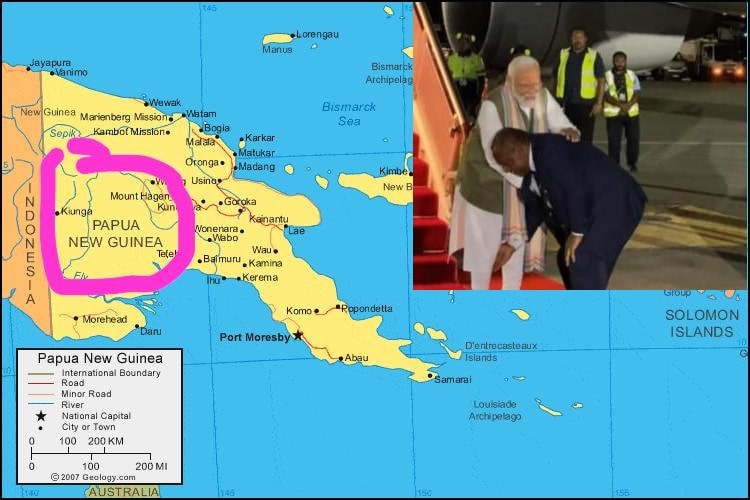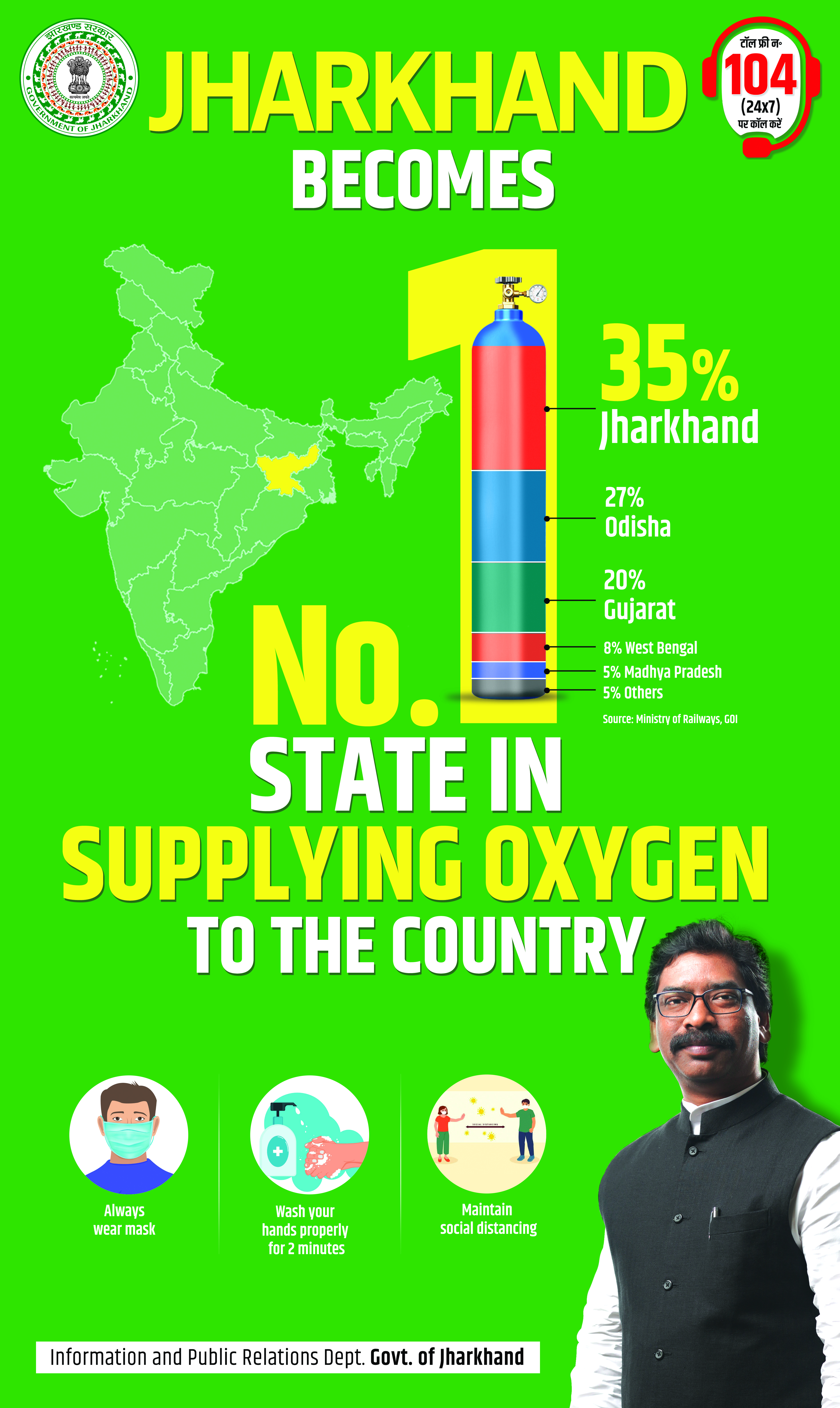
The recent visit of prime minister Mr. Narendra Modi to the capital Port Moresby of Papua New Guinea (PNG) on 22nd May 2023, is emblematic of the widening footprints of India in the strategically located South Pacific Island nations.
It is an extension of India’s ‘Act East policy’ which intends to engage Southeast Asian nations economically and strategically but now extends beyond that and covers the South Pacific.
Mr. Modi’s Visit To Papua New Guinea; First By An Indian Prime Minister
Mr. Modi received a very warm welcome In Papua New Guinea and the prime minister James Marape bending to touch the feet of Modi in keeping with the Indian tradition was unusual and took everyone by surprise. But it showed the genuine honesty of sentiment towards close relationship with India and the importance accorded to it against the global military rivalry between America and more particularly China.
Mr. Modi received two highest civilian awards from PNG and Fiji – the two most important and populous island nations of the Region.
PNG conferred the highest civilian award called the Grand Companion of the Order of Logohu (GCL)on Mr. Modi while Fiji conferred its highest civilian award called the Companion of the Order of Fiji (CF) on him.
A Century of ‘Indian Problem’ And A New Positive Turn With Apology By Fiji’s P.M. Sitiveni Rabuka
Interestingly enough and of great consequence for the Indian presence in the South Pacific, only recently the present prime minister of Fiji Sitiveni Rabuka apologised in his personal capacity to the Indo-Fijians for the military coup laced with violence staged by him in 1987 when he was a senior military officer. It was primarily aimed against them.
This led to the migration by many Indo-Fijians to outside countries mainly to New Zealand and Australia which have developed economy and are nearby. A good number also went to Canada and America.
The migration led to the Indian population dwindling from being a majority to a minority. At present the Indian population is about 37.6% out of a total population of only 827900. The native Fijians are now 56.8%.
It may be noted that the Indians particularly from Bihar and U.P. went to Fiji which was then a British colony, from 1879 to 1916 under the indentured system to work as Coolies(Girmits) primarily in the sugar plantations owned by the Whites.
Around 1910 despite all the odds, The Indians had started settling down in Fiji and making their presence felt socio-economically and later politically. The native Fijians were lagging behind and their population had been decreasing since 1845 starting with the measles epidemic.
It was felt then that the native Fijians would get extinct and the Indians would populate the country. This gave rise to worry for the Britishers as colonialists and various interested groups like Methodist Church and local White Settlers.
The native Fijians felt strongly about it and developed a strong anti-Indo-Fijian attitude with its reverberations in societal life including more importantly racial politics.
It was called “Indian Problem” which with its historical twists and turns has continued to fester till now and bedevil the racial relationship within the country. In this context, the apology by none other than Sitiveni Rabuka is an important conciliatory move.
With Indians in the minority, they no more hold the threat of ruling over the native Fijians and are now consigned to play a politically subservient role. Rabuka who is the present prime minister, has his coalition government supported by the NFP (National Federation Party) which is essentially a party of the Indo-Fijians.
Thus, Fiji which is deemed to be the pivot of the South Pacific and Gateway to the Region now being friendly to India and trying to sweep aside its past anti-Indo-Fijian approach, gives rise to a situation for greater diplomatic maneuverability for India in the Region.
Why Inexplicable Marape’s Bending or Rabuka’s Apology
Analysts are a little befuddled as to how to explain the rather strange gesture of Mr. Marape’s of trying to touch the feet of Mr. Modi or Mr. Rabuka’s apology to Indo-Fijians in a world where nations commit much heinous crime and plunder without ever doing so.
The analysts given to their habit of imputing political motive to any such move possibly miss the point when it comes to the South Pacific which is unique and traditionally untouched by the rest of the world.
One way of looking at it can be that this Region has been ensconced in a global corner when seen against a flat map. On the whole the inhabitants are straightforward and warm-hearted people with a culture of simple communal life. They are not given to very complex deceptive moves of international politics.
Hence, either Marape’s bending to touch the feet or Rabuka’s personal apology may be taken as the hallmark of the rather less complicated and positive side of the character of that Region and not as any personal or national weakness. When need be, they can be very proud people.
Hence, while being appreciative and drawing satisfaction, India should not get carried away by such gestures and while framing policy should not see it as a sign of deference to their superiority.
India and FIPIC As A Multilateral South Pacific Forum
More important event for India during the visit was the holding of the third FIPIC (Forum of India-Pacific Islands Co-operation) Summit on 22nd May 2023, involving fourteen island nations of the Region.
These are Fiji, Micronesia, Marshall Islands, Nauru, PNG, Solomon Islands, Tuvalu, Kiribati, Samoa Nive, Cook Islands, Vanuatu, Palau and Tonga.
As a large number of Indians are not familiar with the politics of the South Pacific Region and India’s outreach, they are unlikely to have heard the names of some of these countries.
This is reflective of the diplomatic distance hindered by the physical distance that India had till recently with the Region which particularly due to the Chinese-American rivalry has shot into great prominence and a potential theatre of war.
The Forum was constituted in 2014 during Mr. Modi’s visit to Fiji and the first meeting was held there. The second one was held in India in 2015. After that, there has been a gap and only now the third FIPIC summit has been held. It also lays the foundation for India in the Region as it grows in stature as a world power with more active role there in the future.
Possibly after a somewhat slow start, now India is trying to accelerate and consolidate the relationship with the South Pacific countries whose strategic importance has suddenly grown substantially due to the intensifying
China-America rivalry in the Pacific.
In the latest and third FIPIC summit in PNG, India extended support and help on a variety of issues including satellite technology, Education, Medical, Information Technology and Digitalisation, Clean Energy, Solar electrification, Climate Change and so on.
Climate Change which assumes great importance for these island nations as they fear serious adverse climatic effects on their islands including submergence in the ocean due to the rise of water level. They feel that they are not being sufficiently heard in the international institutions on this grave issue threatening their very existence.
On the whole, distinctively these Indian co-operations are mainly in the form of developmental assistance. Much to the comfort of the now wary island nations, there is no political or military engagement as a rider unlike that in the case of China or America or for that reason Australia.
( Part 2 of this article written by Pradeep Kumar Sinha will be published here on June 21, 2023)
